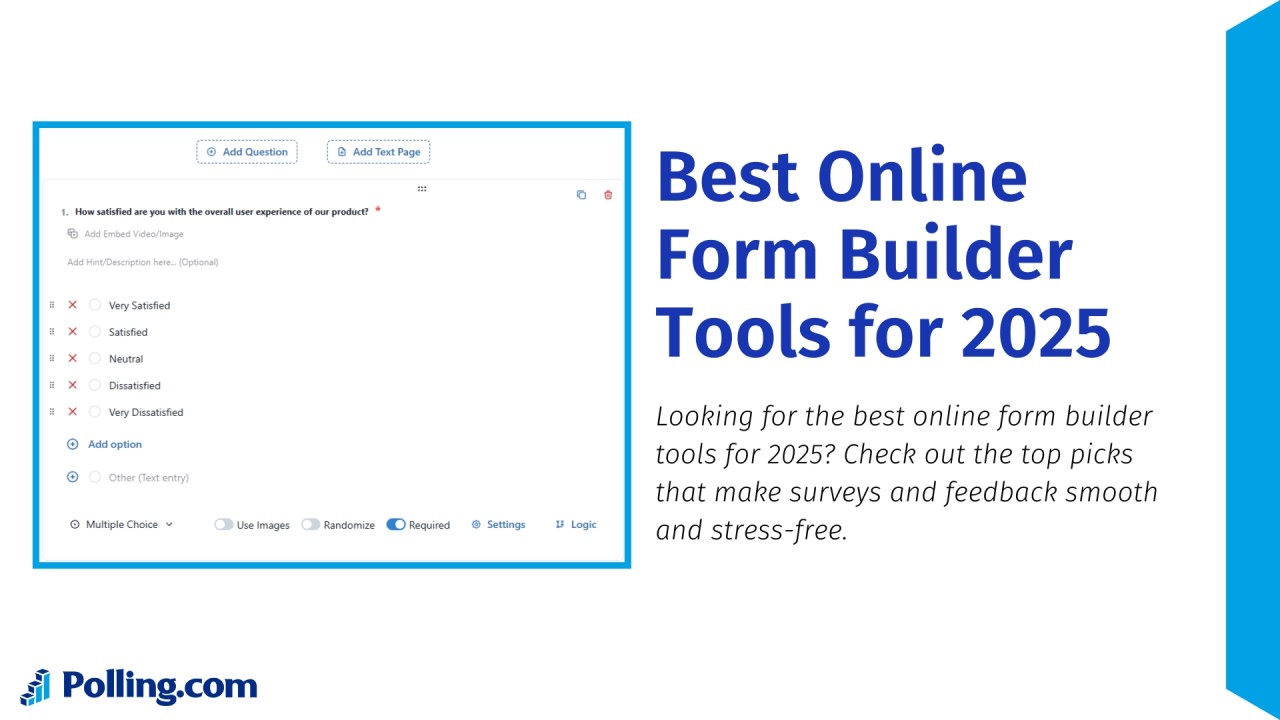
Best Online Form Builder Tools for 2025
In today’s digital-first world, the ability to capture data quickly and efficiently is a game-changer.
Businesses rely on forms to generate leads, marketers use them to measure campaigns, educators conduct surveys, and researchers track insights at scale.
Online free form builders make this possible, and their use is only increasing as organizations seek smarter ways to connect with audiences.
Among the many options available, Polling.com stands out for its intuitive design, accessible free plan, and robust analytics that transform raw responses into meaningful results.
Why Choosing the Right Online Form Builder Matters
A free online form builder does more than just gather responses; it shapes how people interact with your brand, determines the accuracy of the insights you collect, and influences how smoothly your processes run.
The right tool doesn’t just collect data; it drives better results by improving user experience, streamlining operations, and strengthening trust.
Business Use Cases
In business, forms are one of the most direct touchpoints with customers.
A well-placed lead capture form can turn casual visitors into qualified prospects, while feedback forms reveal how customers truly feel about your products or services.
Event registration forms simplify sign-ups, payment handling, and attendance tracking, removing the need for manual coordination.
Even something as basic as an e-commerce checkout form can make or break conversions, and a streamlined design reduces cart abandonment and boosts revenue.
With a platform like Polling.com, businesses can easily build, customize, and analyze these data collection forms while leveraging advanced analytics to see what’s working and where improvements are needed.
Research & Education
For researchers and educators, form builders are indispensable tools for collecting reliable, structured data.
Academic surveys, classroom feedback, and institutional studies can all be managed efficiently with digital forms.
Educators often rely on features like skip logic to adapt questions based on responses, while researchers use secure storage to ensure data integrity.
Outside academia, organizations use forms builders for NPS tracking to measure satisfaction and even political polling to capture public sentiment at scale.
Survey tools such as Polling.com simplify the process by offering advanced features that improve accuracy, reduce bias, and make large datasets easier to interpret.
Brand Perception & Customer Experience
Every form leaves an impression on the person filling it out.
A clunky, confusing form can frustrate users and drive them away, while a clean, intuitive one fosters trust and encourages completion.
Custom branding, from logos and colors to fonts and layouts, ensures your forms feel like a natural extension of your organization.
Small touches such as progress bars, a form builder with conditional logic, and mobile-friendly layouts make the process smoother and more engaging.
With Polling.com, companies can deliver forms that not only capture data but also strengthen credibility and enhance customer experience at every interaction.
Criteria for Selecting the Best Online Form Builder
Not all form builders are created equal.
The best online form builder balances simplicity with power, helping you create professional, user-friendly forms while still meeting your business or research needs.
Below are the key criteria to consider when evaluating which tool is the best fit.
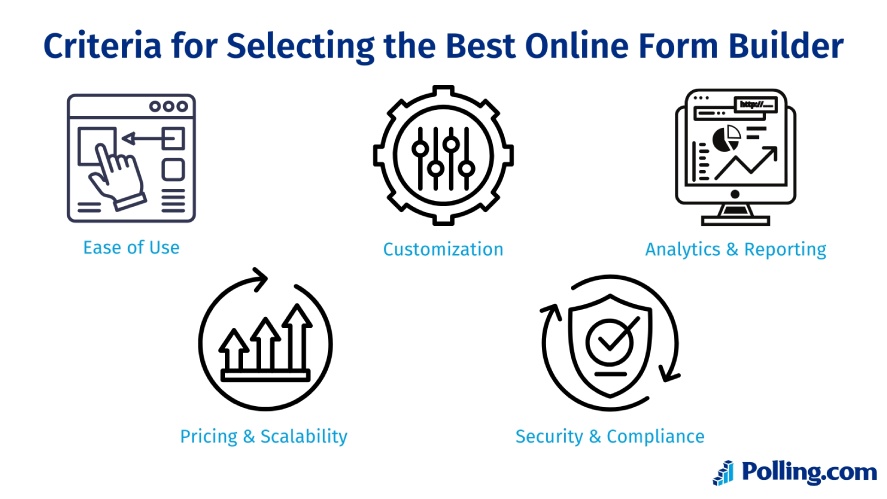
Ease of Use
A form builder should save you time, not add complexity.
Look for platforms with drag-and-drop editors and ready-made templates that make building a form quick and seamless, letting you publish forms in minutes.
This ensures that even non-technical users, like marketers or educators, can build effective forms without coding experience.
Customization
Your forms should reflect your brand and goals.
Features like custom logos, colors, fonts, and a form builder with customizable templates keep forms on-brand, while conditional logic personalizes the experience by showing or hiding fields based on user input.
Integration with tools such as CRMs, email marketing platforms, or payment gateways makes workflows seamless and scalable.
Analytics & Reporting
Collecting responses is only half the job; making sense of the data is where value lies.
Advanced free web form builders offer real-time response tracking, segmentation, and trend visualization, giving you clear insights into customer behavior, survey results, or lead quality.
Polling.com, for example, provides built-in analytics dashboards that help you quickly spot patterns and take action.
Pricing & Scalability
The right form builder should grow with you.
Many best form builders offer free plans for basic needs like simple surveys or feedback forms, while paid tiers unlock enterprise-grade features such as team collaboration, automation, and advanced integrations.
This flexibility ensures you only pay for what you need, when you need it.
Security & Compliance
When handling sensitive information, security isn’t optional.
Look for form builders that meet GDPR, HIPAA, or industry-specific compliance standards, along with features like data encryption and secure storage.
Polling.com ensures that both organizations and their users can trust the platform to keep data safe and compliant.
7 Best Online Form Builder Apps in 2025
With dozens of free online form generators and Google Forms alternatives on the market, it can be tough to find the right online form builder. We’ve rounded up the best options for 2025, starting with Polling.com.
1. Polling.com – The All-in-One Form Builder for Surveys & Polling
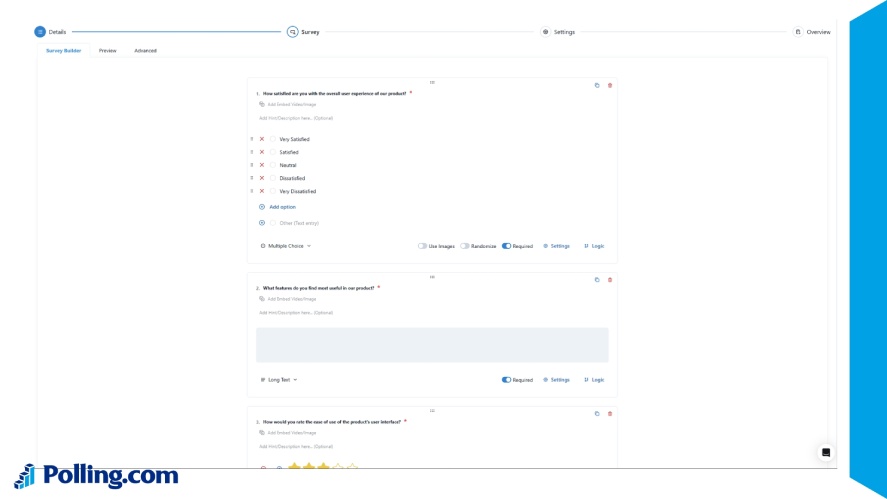
Pros:
- Free plan includes unlimited responses and questions
- Real-time analytics and dashboards
Cons:
- Less well-known than long-established platforms
- Primarily geared toward surveys and polling tools
Polling.com combines an intuitive drag-and-drop survey builder with advanced capabilities like AI-driven form suggestions, branching logic, and unlimited questions, even on the free tier.
You get real-time insights through dashboards, customizable templates, and powerful form builders with integrations.
It’s ideal for businesses, researchers, and campaigners seeking a data-rich, flexible form solution.
2. Typeform – Engaging, Conversational Forms
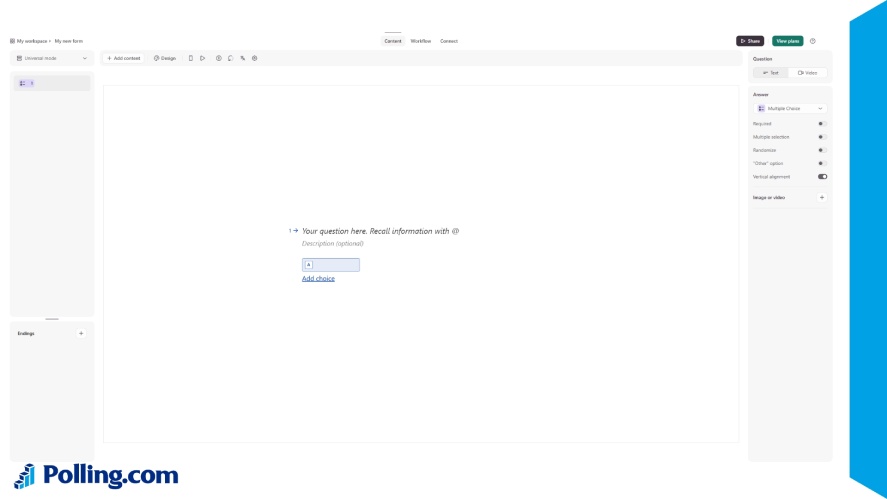
Pros:
- Conversational one-question-at-a-time interface increases engagement
- Clean, user-friendly design is widely praised
Cons:
- Limited free tier and relatively expensive for higher plans
- Logic customization isn’t as advanced as some competitors
Typeform transforms surveys into immersive experiences, positioning itself as a leading conversational form builder software with multimedia support.
Its design-driven interface makes it perfect for engaging audiences, particularly marketers and UX researchers, who especially appreciate its aesthetic polish.
While simple to use and visually appealing, the free version is restrictive and premium upgrades can be pricey.
3. Google Forms – Simple & Free
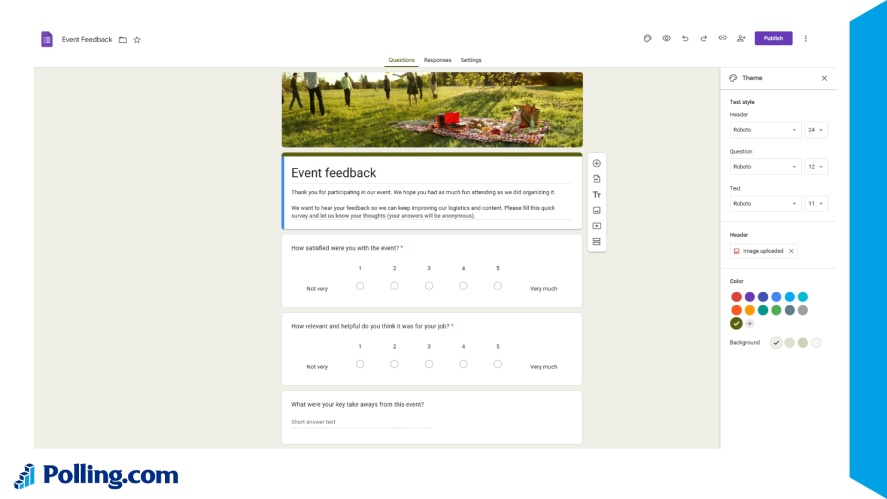
Pros:
- Completely free, unlimited forms and responses
- Native integration with Google Workspace tools like Sheets and Drive
Cons:
- Limited customization; lacks branding and advanced logic features
- Very basic interface unsuitable for professional or public-facing forms
Google Forms builder remains a go-to solution for quick surveys and internal feedback thanks to its simplicity and seamless integration with Google tools.
Though it’s perfect for classrooms or business teams needing fast, no-frills forms, it’s not built for form customization or advanced analytics.
4. Jotform – Highly Versatile & Feature-Rich
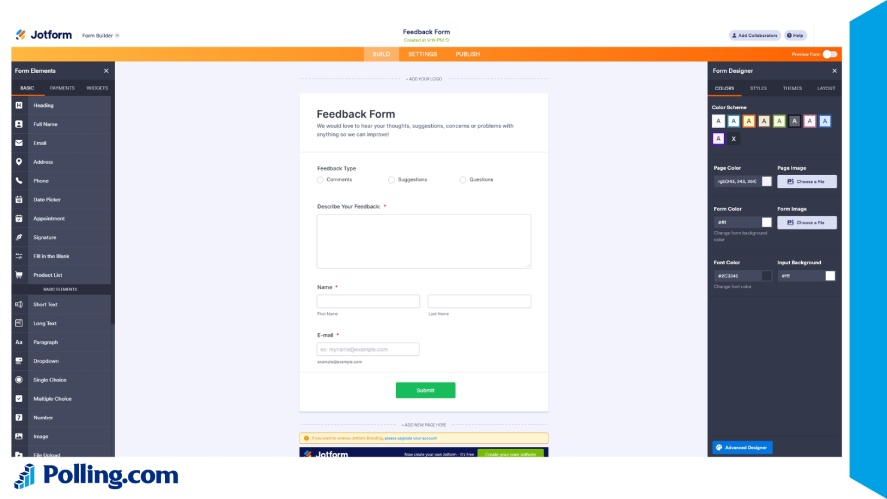
Pros:
- Massive template library (10,000+) and drag-and-drop interface
- Strong compliance support (HIPAA, GDPR) and automation features
Cons:
- Free tier is limited (5 forms, 100 submissions/month)
- Advanced features require higher-priced plans
Jotform is a powerhouse platform for organizations needing deep functionality.
Its AI form assistant, payment processing, e-signatures, and workflow integrations make it ideal for regulated industries, nonprofits, and SMBs with complex needs.
However, power comes at a cost and higher tiers become expensive.
5. Formstack – Enterprise-Grade Workflow Tool
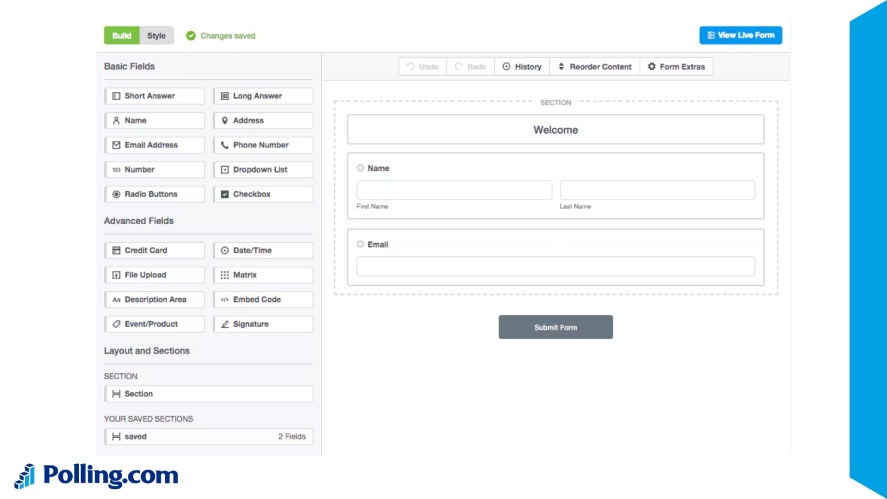
Pros:
- Advanced automation and e-signature capabilities
- Deep compliance support (HIPAA, GDPR) for sensitive data
Cons:
- No free tier; higher cost may deter small teams
- Complexity can be overkill for simple form needs
Formstack excels for enterprises needing a form builder with automation features embedded within secure workflows.
With robust compliance, branding control, and routing logic, it’s built for professional environments. However, smaller teams may find it too feature-heavy for their day-to-day use.
6. Wufoo – Fast, Secure Form Creation
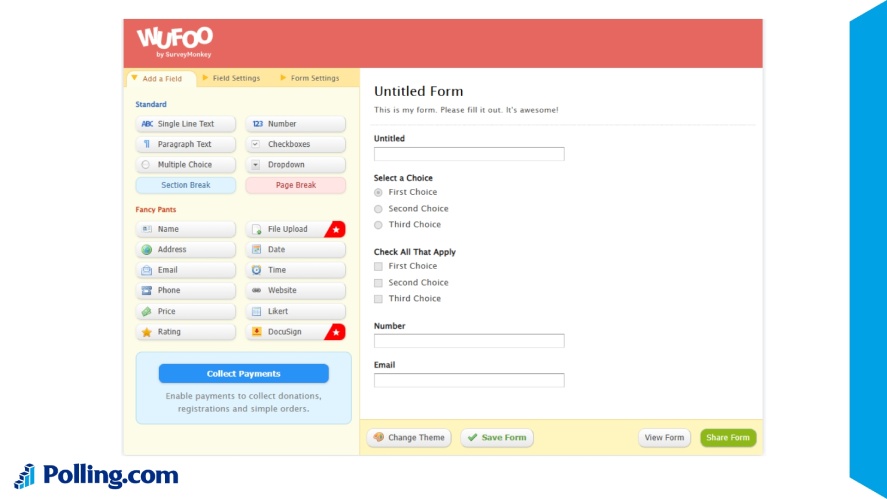
Pros:
- Strong security features: password protection and field-level encryption
- Quick, clean interface for rapid form setup
Cons:
- Free plan limited to 5 forms and 100 entries
- Interface feels dated and less modern than newer tools
Wufoo stands out for its emphasis on security and ease of use. Its intuitive setup and encryption features make it a reliable choice for sensitive or internal use cases.
However, advanced users may feel limited by its design and the dated UI.
7. Microsoft Forms – Deep Microsoft Ecosystem Integration
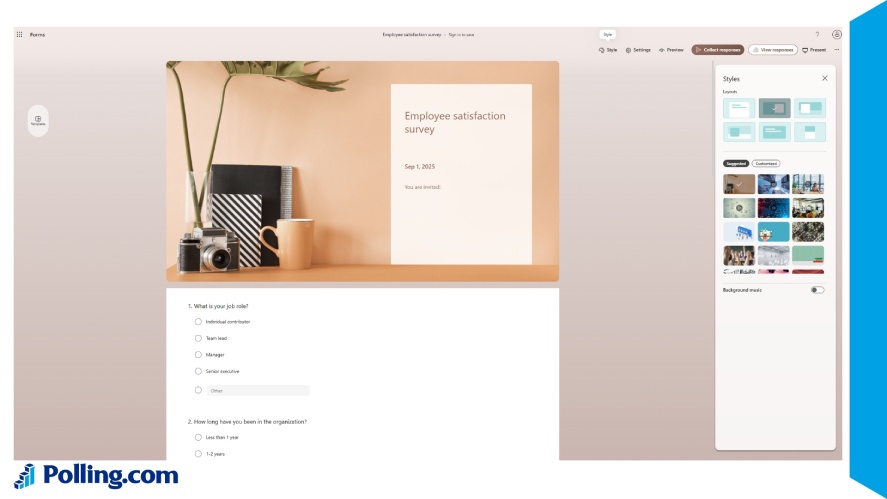
Pros:
- Seamless real-time collaboration within Microsoft 365 apps
- Ideal for Office-centered organizations
Cons:
- Limited customization and logic capabilities
Microsoft Forms delivers a familiar and collaborative form experience for users already immersed in the Microsoft ecosystem.
It’s perfect for educational institutions and businesses, though it lacks the design flexibility and power of dedicated form builders.
Comparison Table of the Best Online Form Builders
| Feature/Tool | Polling.com | Typeform | Google Forms | Jotform | Formstack | Wufoo | Microsoft Forms |
|---|---|---|---|---|---|---|---|
| Free Tier | Unlimited questions & responses | Limited (10 responses/month) | Fully free, unlimited forms | Limited (5 forms, 100 submissions) | None | Limited (5 forms, 100 entries) | Free with a Microsoft account |
| Ease of Use | Drag-and-drop builder, AI suggestions | Conversational one-question-at-a-time, clean design | Very simple, basic | Drag-and-drop, intuitive | More complex, enterprise-focused | Quick setup, simple interface | Familiar to Office users |
| Customization | Branching logic, templates | Conversational design, multimedia | Very limited | Highly customizable, 10k+ templates | Advanced branding & workflows | Basic customization, dated UI | Limited options |
| Analytics & Insights | Real-time dashboards, data-rich | Advanced analytics | Limited (needs Sheets) | Strong reporting & workflow insights | Advanced analytics in workflows | Basic reporting | Limited analytics |
| Integrations | Strong integrations | Moderate | Extensive, via add-ons and Google Workspace ecosystem | Extensive, payments & automation | Deep workflow & compliance integrations | Basic | Microsoft 365 ecosystem |
| Compliance & Security | General secure forms | Standard | Basic | HIPAA, GDPR compliance | HIPAA, GDPR enterprise-grade | Field-level encryption, password protection | Enterprise-level Microsoft security |
| Best For | Businesses, researchers, political campaigners | Marketers, UX researchers, audience engagement | Classrooms, small teams, internal use | Nonprofits, SMBs, regulated industries | Enterprises, professional workflows | Sensitive internal use | Educational & business teams in Microsoft ecosystem |
How Polling.com Stands Out From the Competition
Polling.com sets itself apart through its depth of features, user-friendly interface, and data-driven approach.
Here’s what makes it unique:
- Unlimited Surveys and Responses on Free Plan: Unlike many platforms that restrict submissions behind paid tiers, Polling.com’s free plan offers truly unlimited surveys and responses, enabling expansive data collection without upfront investment.
- Advanced Analytics Powered by AI: Polling.com form builder goes beyond basic tallies. The platform includes real-time dashboards and predictive analytics, complete with trend spotting, respondent segmentation, and automation tools that elevate survey insights.
- Enterprise-Level Targeting & Customization: You can embed surveys across websites, apps, and other embedded environments. Polling.com survey platform supports branching logic and even SDK integration for advanced workflows.
- AI-Enhanced Survey Creation: The platform offers intuitive tools that let you build online forms with AI-assisted generation and templates tailored to product feedback, NPS, and other use cases—making it fast to build engaging, brand-customized surveys even without technical expertise.
- Tailored for Real-Time Insights and Quick Action: With features like real-time result charts, demographic breakdowns, and export capabilities, Polling.com data collection empowers teams to act on feedback immediately.
In essence, Polling.com combines simplicity, scalability, and advanced tools. It’s a versatile platform that serves smartly across business, research, education, and political use cases.
Final Thoughts
Every best free online form builder has its strengths: Typeform for engagement, Google Forms for simplicity, and Formstack for enterprise needs.
But if you want a platform that balances ease of use with powerful analytics and scalable features, Polling.com is the most versatile choice.
It’s built not just to collect responses, but to turn data into insights, whether you’re a business, a researcher, or part of a political organization.
